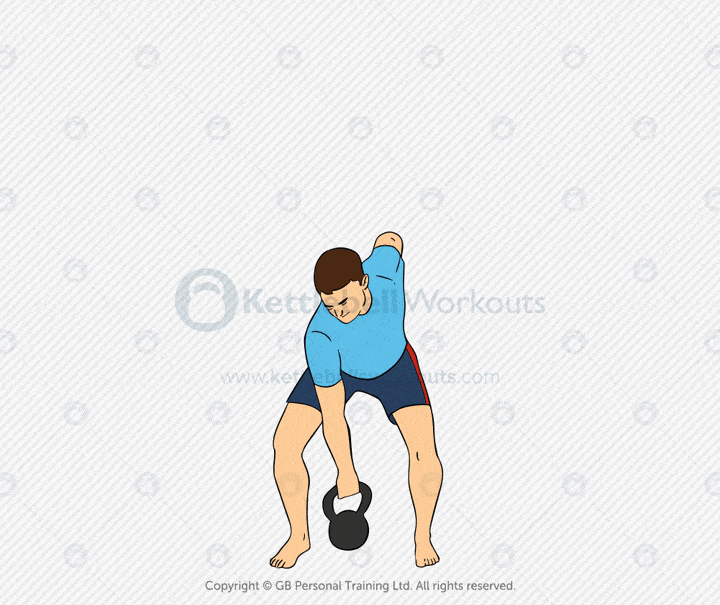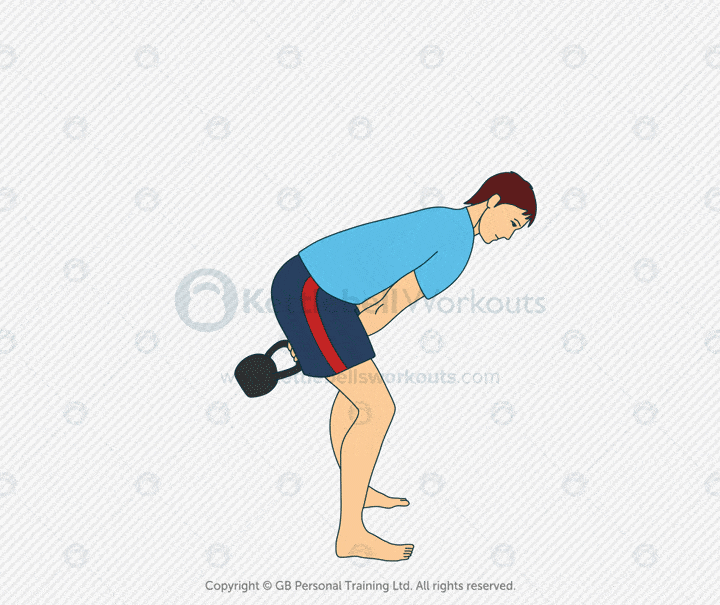Last Updated on 4 July 2025 by Greg Brookes
One of my favourite ways to program kettlebell training for clients is by using pyramid workouts. Pyramid workouts combine structured progression, built-in warm ups, an intense peak, and a gradual taper to finish strong.
I’ve used kettlebell pyramid workouts for over 15 years to build strength, endurance, and conditioning efficiently while keeping motivation high.
In this article, I’ll explain what pyramid workouts are, how they differ from ladder workouts, when to use them, advanced programming tips, and share sample kettlebell pyramid workouts to integrate into your training this week.
What Is a Kettlebell Pyramid Workout
A kettlebell pyramid workout involves increasing reps, load, or time each set to a peak, then decreasing back down. For example:
- 1 rep
- 2 reps
- 3 reps
- 2 reps
- 1 rep
This creates a natural progression and taper, allowing you to build volume efficiently while warming up and cooling down within the same structure.
Types of Pyramid Workouts
Here’s a short introduction before diving into the different types of pyramid workouts you can use.
- Rep Pyramids: These involve increasing reps each set to a peak, then decreasing back down. For example:
- 2 – 4 – 6 – 4 – 2 reps.
- Load Pyramids: Increase kettlebell weight each set to a peak, then reduce back down. For example:
- 16kg – 20kg – 24kg – 20kg – 16kg.
- Time Pyramids: Increase duration each set to a peak, then reduce back down. For example:
- 20s – 30s – 40s – 30s – 20s work intervals.
- Rest Pyramids: Adjust rest periods inversely with work periods for added intensity. For example:
- Work time stays at 30s; rest periods: 40s – 30s – 20s – 30s – 40s.
- Movement Pyramids: Add an extra exercise each round or remove one each round, creating a pyramid structure of movements.
Ladder Workouts vs Pyramid Workouts
It’s important to understand the difference between ladder workouts and pyramid workouts when planning your kettlebell programming.
Ladders generally go in one direction – either ascending or descending. For example:
- Ladder: 1 rep, 2 reps, 3 reps, 4 reps, 5 reps.
Pyramids combine both ascending and descending within the same workout. For example:
- Pyramid: 1 rep, 2 reps, 3 reps, 2 reps, 1 rep.
When to Use Ladders vs Pyramids
Both ladders and pyramids have their place in programming. Here’s a short guide to when I use each:
- Ladders: Great for learning new exercises or building confidence with volume. Ascending ladders progressively challenge the body, while descending ladders help maintain quality under fatigue.
- Pyramids: Ideal for building strength, endurance, and confidence in a single workout. The natural taper of pyramids is psychologically rewarding and ensures effective warm up and cool down built into the structure.
Programming Pyramid Workouts Across a Week or Month
Here’s how I integrate pyramid workouts into client programmes for optimal results.
Weekly Example:
- Monday: Strength pyramid (eg. clean and press pyramid)
- Wednesday: Conditioning pyramid (eg. swing time pyramid)
- Friday: Load pyramid (eg. goblet squat load pyramid)
Monthly Progression Example:
- Week 1: Rep pyramids (build baseline volume)
- Week 2: Time pyramids (build conditioning and endurance)
- Week 3: Load pyramids (increase resistance)
- Week 4: Mixed pyramids (combine rep, load, and time pyramids)
This rotation prevents plateaus and keeps workouts varied and motivating.
Advanced Pyramid Variations for Progression
If you’ve mastered the basics, here are some advanced pyramid variations to challenge yourself further.
1. Double Pyramid: Perform two pyramid structures back-to-back with different exercises. For example:
- Pyramid A: Clean and Press (1-5-1)
- Pyramid B: Goblet Squat (2-10-2)
2. Reverse Pyramid: Start with the heaviest load or highest reps and taper down, focusing on power and explosiveness as fatigue reduces.
3. Complex Pyramid: Combine multiple exercises within each rung. For example:
- 1 rep clean and press each side, 1 goblet squat
- 2 reps clean and press each side, 2 goblet squats
- 3 reps clean and press each side, 3 goblet squats
- Up to 5, then descend back down.
These advanced formats ensure continuous adaptation and keep training fresh.
Sample Kettlebell Pyramid Workouts
Here are three effective kettlebell pyramid workouts you can integrate into your programme this week.
Strength Rep Pyramid
This is one of my favourite structures for building pressing strength.
Format: 2 – 4 – 6 – 4 – 2 reps each side
- Clean and Press Left x 2 reps, then Right x 2 reps
- Clean and Press Left x 4 reps, then Right x 4 reps
- Clean and Press Left x 6 reps, then Right x 6 reps
- Clean and Press Left x 4 reps, then Right x 4 reps
- Clean and Press Left x 2 reps, then Right x 2 reps
Why it works: Builds pressing volume while reinforcing clean technique with a natural taper.

Conditioning Time Pyramid
Use this for cardiovascular conditioning and power endurance.
Format: 20s – 30s – 40s – 30s – 20s work, rest 20s between sets
- Two-Handed Swings x 20s
- Two-Handed Swings x 30s
- Two-Handed Swings x 40s
- Two-Handed Swings x 30s
- Two-Handed Swings x 20s
Why it works: Elevates heart rate with manageable peaks, promoting conditioning and fat loss.

Load Pyramid Circuit
Great for building leg strength under varying loads.
Format: Increase kettlebell weight each set to peak, then reduce back down
- Reverse Lunge 16kg x 5 reps per side
- Reverse Lunge 20kg x 5 reps per side
- Reverse Lunge 24kg x 5 reps per side
- Reverse Lunge 20kg x 5 reps per side
- Reverse Lunge 16kg x 5 reps per side
Why it works: Builds leg strength and reinforces lunging mechanics under different loading demands.

Coach’s Insight: Greg’s Take
Pyramid workouts are brilliant for building confidence and volume safely. They feel achievable because of the natural taper and psychologically rewarding peak.
I often use them as finishers to strength sessions or as stand-alone conditioning workouts when time is short but I want to achieve maximum impact.
Remember, never sacrifice form to reach the peak of the pyramid. Quality movement under load is always the priority.
Final Thoughts
Kettlebell pyramid workouts are a powerful way to build strength, endurance, and conditioning efficiently. Whether you use rep pyramids to build volume, load pyramids to build strength, or time pyramids for conditioning, they keep training structured, engaging, and progressive.
Add them into your programme this week to experience their benefits first-hand, and explore other kettlebell workout formats such as EMOM, AMRAP, circuits, flows, complexes, Tabata, intervals, and WODs to keep your training varied and effective.
Want to explore all kettlebell workout styles? Check out my complete Kettlebell Workout Formats Guide to find the best format for your goals.
Frequently Asked Questions
A workout where reps, load, time, or rest increase to a peak and decrease back down, creating a structured training session.
Yes. They build intensity progressively, maximising calorie burn and metabolic effect.
Absolutely. Start with lower peaks and focus on technique.
Choose weights allowing crisp technique for all reps, even at the peak.
Ladders go one direction (up or down); pyramids go up then down in the same workout.



Hello Greg,
You are the 1st person who introduced me this kettle bell tool. It is very interesting. In the Countdown Pyramid Workouts method to attain the both fat loss and strength training should we increase the weights gradually by decreasing the rep range ?
Thank you.
Hello Christo,
You can keep the reps as they are and then increase the weight once you can complete all the reps. Choose a weight that challenges you so you cannot complete all the reps and then push to complete 1 more rep each workout.
Wow Greg, I so appreciate this informative layout. I love kettlebells and pyramids and combining them as you’ve done will help lots of us! If only I could master the turkish get up! Reed
Hi Greg
Many thanks for these workouts. A gym close to mine is closing for three months so mine is getting very busy. I was looking for a workout that can be completed in a small space and without waiting for equipment to come free. I want to lose fat so I will alternate between the two fat loss routines. I’ve already done the climbing pyramid though I could not do the full 30 seconds for some exercises towards the end of the pyramid. I found it useful to take a pen and paper as this stopped me losing my place and allowed me to record repetitions and weight in the rest periods so I can track progress.
One question – on the count down pyramid should I rest between circuits and if so for how long? It does not look as hard as the climbing pyramid but I guess I’ll find out when I’ve done it.
Once again many thanks
Colin
Good question Colin, yes you can take a short rest after each round but ultimately you should try and complete the entire workout as quickly as possible with good technique. If you time how long it takes to complete you can work on beating your time each time. Enjoy!
Hi Greg, I love all your tutorials They are great and you explain very clear.
I have bought two of your books and they have helped me to make big progress with the KB and fitness in general
Thank you very much for your help and congratulations. You are a professional?
Thanks Carolina, you are very kind. I’m pleased that the workouts and tutorials are helping you reach your goals. Let me know if you need anything further.
Great work. I really enjoy your workouts/tutorials. I notice on your single leg deadlift you hold the bell on the leg that goes back..I have seen others load the side that stays planted. Is one as good as the other? or does one have advantage over the other or just personal preference?
Thanks again.
Hi Alan, it is very important that you use the opposite arm as the leg planted, as I demonstrate, otherwise you don’t stimulate the natural cross body muscular sling system. The body is naturally connected via shoulder to opposite hip hence why this format is important. The same connection happens during the Turkish Get Up so you will find if you struggle with the Get Up you will struggle with the Single Leg Deadlift and vice versa. It’s a very important exercises for core rotation.
Awesome article! I use pyramids frequently, but I never thought of rest pyramids and sometimes forget about others I have used in the past.
Brilliant, pleased you liked it Elan and found it useful.